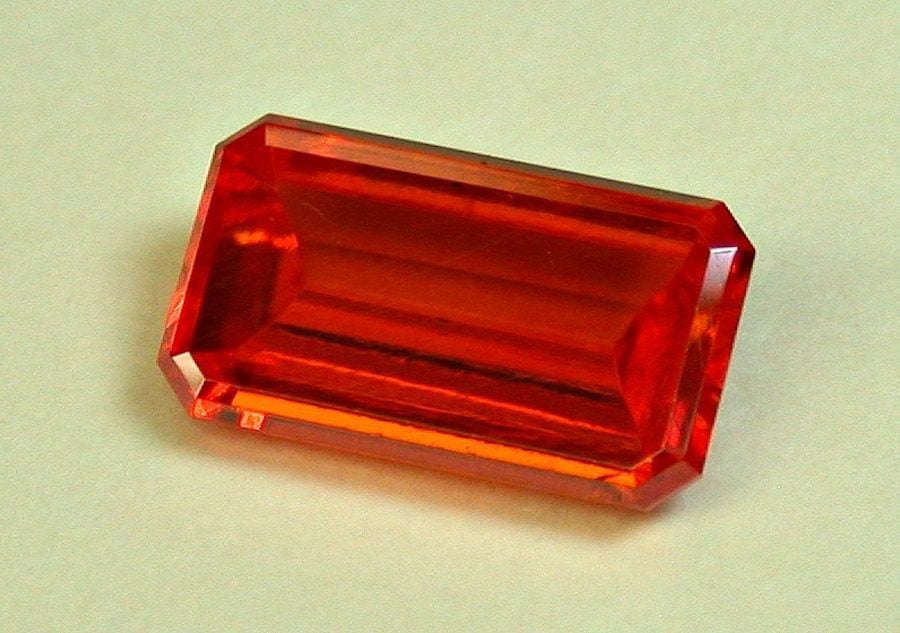Wulfenite Value, Price, and Jewelry Information
Although aesthetically magnificent wulfenite crystals are often too thin, soft, and sensitive to cut for jewelry, rare faceted pieces are greatly prized by collectors. The red of wulfenite, especially from the Red Cloud Mine in Arizona, is one of the richest colors in nature.
2 Minute Read
Although aesthetically magnificent wulfenite crystals are often too thin, soft, and sensitive to cut for jewelry, rare faceted pieces are greatly prized by collectors. The red of wulfenite, especially from the Red Cloud Mine in Arizona, is one of the richest colors in nature.
Start an IGS Membership today
for full access to our price guide (updated monthly).Wulfenite Value
What is Wulfenite?
Wulfenite and stolzite form a mineral series, as the molybdenum (Mo) and tungsten (W) analogues, respectively.
Does Wulfenite Make a Good Jewelry Stone?
Many localities across the globe produce wulfenites. However, cuttable material is very rare, indeed. Individual crystals usually have a tabular structure. As a result, they're frequently too thin to find a fragment suitable for cutting.
Should a faceter acquire a suitable piece, even more challenges await. These beautiful gems combine very low hardness (2.5 to 3) with sensitivities to both heat and vibration. You're more likely to find wulfenites in mineral collections than in jewelry collections.
Any faceted wulfenites in jewelry should have protective settings. Although not well suited for jewelry use, faceted pieces make stunning collector's gems.
Identifying Characteristics
Wulfenites may show an anomalous biaxial optic character.
Under physical pressure, some wulfenite crystals may generate an electric charge. This is known as the piezoelectric effect.
Are There Synthetic Wulfenites?
Laboratories have synthesized both wulfenites and stolzites through pulled (Czochralski) and flux methods. Sintering cerussite with molybdite (a mineral source of Mo) has also produced synthetic wulfenites. While these synthetics have industrial uses, they have also appeared as attractive crystals and even faceted pieces.
There are no known gemstone treatments or enhancements for wulfenites.
Where is Wulfenite Found?
Notable gem-quality sources include the following:
- United States: Arizona (Glove Mine, Rowley Mine, Red Cloud Mine, Mammoth Mine, others); California; Loudville, Massachusetts; Nevada; New Mexico; Wheatley Mines, Chester, Pennsylvania; Utah.
- Tsumeb, Namibia: yellowish tan crystals up to 5 inches on edge, some facetable.
- Mexico: Los Lamentos (many other locations).
Rough and cut set, wulfenite crystal and modified octagonal-cut gem, 4.3 x 3.2 x 2.7 cm (crystal), 1.32 cts (gem). Ahumada Mine, Los Lamentos, Chihuahua, Mexico. © Rob Lavinsky, www.iRocks.com. Used with permission.
- Algeria; Argentina; Australia; Austria; Chile; China; Czech Republic; Democratic Republic of the Congo; Germany; Sardinia, Italy; Morocco; Poland; Republic of the Congo; Slovakia; Slovenia.
Stone Sizes
Red wulfenites over one carat and yellowish or orange stones over two carats are extremely scarce. The only larger stones come from rough from Tsumeb, Namibia, which has produced crystals several inches across. This material has yielded faceted gems over 50 carats in size. However, this locality produces very few facetable gems very infrequently. Thus, faceters have cut very few stones from this source.
Occasionally, U.S. localities produce crystals both thick and transparent enough for faceting. These include, most notably, the Red Cloud Mine and the Seventy-Nine Mine in Arizona as well as other sources. Some of these crystals have yielded gems up to about five carats.
- Smithsonian Institution (Washington, DC): 46.1, 15.7, 9.6 (pale yellow, Tsumeb); 10+ (orange, Los Lamentos, Mexico).
- Devonian Group (Calgary, Alberta, Canada): 15.25 (yellow, Tsumeb); 9.44 (red, Arizona).
- Private Collection: 54 (yellow, Tsumeb).
Caring for Wulfenite Gemstones
Wulfenites are so soft, copper coins can scratch them. Household dust, which contains silicon quartz, will scratch them even more easily. Treat any wulfenites, whether gems or crystals, very delicately. Resist the urge to just wipe dust off their surfaces. Instead, pat them clean with a lint-free cloth.
Consult our gemstone jewelry cleaning guide for more care recommendations.
Rough and cut set, wulfenite crystal and freeform step eye-cut, 2.0 x 1.1 x 0.3 cm (crystal), 1.02 cts (gem). Red Cloud Mine, La Paz County, Arizona. © Rob Lavinsky, www.iRocks.com. Used with permission.
Joel E. Arem, Ph.D., FGA
Dr. Joel E. Arem has more than 60 years of experience in the world of gems and minerals. After obtaining his Ph.D. in Mineralogy from Harvard University, he has published numerous books that are still among the most widely used references and guidebooks on crystals, gems and minerals in the world.
Co-founder and President of numerous organizations, Dr. Arem has enjoyed a lifelong career in mineralogy and gemology. He has been a Smithsonian scientist and Curator, a consultant to many well-known companies and institutions, and a prolific author and speaker. Although his main activities have been as a gem cutter and dealer, his focus has always been education. joelarem.com
International Gem Society
Related Articles
Black Diamond Value, Price, and Jewelry Information
Chameleon Diamond Value, Price, and Jewelry Information
Gray Diamond Value, Price, and Jewelry Information
Green Diamond Value, Price, and Jewelry Information
Latest Articles
Quartz Toxicity: Understanding the Risks for Jewelers and Wearers
Synthetic Amethyst: What is it and How is it Made?
Hambergite Value, Price, and Jewelry Information
Pearl Simulants: How to Spot Faux Pearls
Never Stop Learning
When you join the IGS community, you get trusted diamond & gemstone information when you need it.
Get Gemology Insights
Get started with the International Gem Society’s free guide to gemstone identification. Join our weekly newsletter & get a free copy of the Gem ID Checklist!
